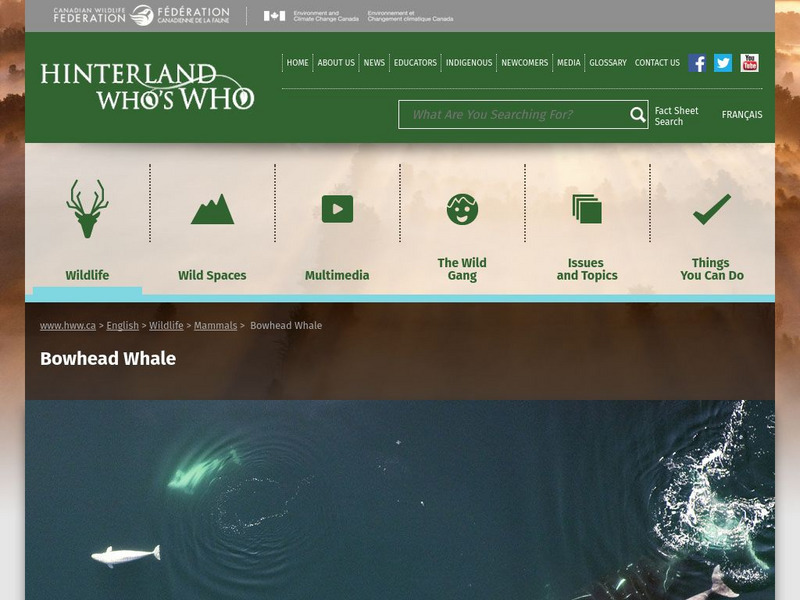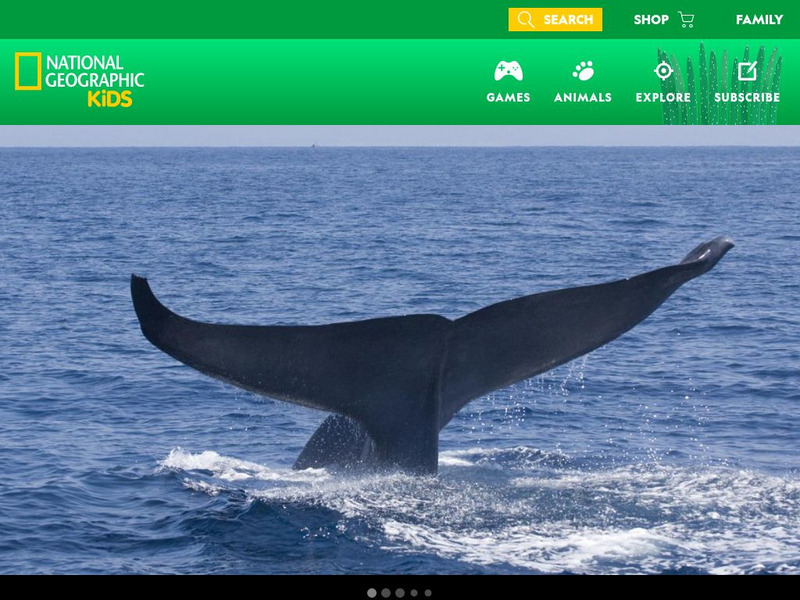Hi, what do you want to do?
Curated OER
Blue Whales
In this comprehension worksheet, students read a 1-page expository text about blue whales and then complete 3 short answer and 2 multiple choice questions.
Curated OER
Whales
Learners compare and contrast the two types of whales. In this biology lesson, students research the characteristics of their assigned whale. They compile their findings in a folder.
Curated OER
How Big is Big?
The blue whale is the focus of this life science worksheet. Students read an excellent selection on the blue whale, and answer ten comprehension questions. Then, students are divided into two groups. Each group has to estimate how big 85...
Curated OER
Whales
Learners study the history of whales. In this whale lesson plan, students research two types of whales, color a tile, and write a one page paper. The tiles may be combined to make a group picture.
Curated OER
HOW BIG IS A BLUE?
Students compare the lengths of whales using different lengths of rope. They illustrate one whale in life-size proportion.
Ask a Biologist
It’s a Plankton Eat Plankton World
For as small as they are, plankton sure play an enormous role in maintaining marine ecosystems. Dive into an investigation of these tiny organisms with a hands-on life science activity in which children cut out pictures of sea...
Curated OER
Whale Form and Function
Young scholars identify similarities and differences in specializations of morphology among a variety of cetaceans and approximate the reasons for these specializations.
Curated OER
Whales
Write factual accounts, reports and express personal viewpoints about whales. They eill also write on a variety of topics related to whales, shaping ideas and making choices in language and form.
Curated OER
Plankton in the Air
Here is a lab activity adequate for use with any full lesson plan on environmental factors that shape animal adaptations or marine animal characteristics. Pupils will discuss the role plankton plays in the environment and filter-feeding...
Curated OER
Exploiting Antarctica
Students read the story and diary "Lizzie's diaries from Antarctica and Antarctica" to get massive clean-up. Students discuss their knowledge of life in Antarctica and raise the fact of the Amundsen-Scott South Pole Station and its...
Curated OER
Vocab-u-lous! Build a Fabulous Vocab
In this vocabulary activity, students decipher the correct choice of word to complete the sentence. All words begin with the letter "B."
Curated OER
Wildlife Conservation III
Discuss the importance of wildlife conservation. Learners talk about the animals and plants on the US Fish and Wildlife Services list of endangered and threatened species. Then, they engage in a detailed discussion of the reasons these...
Curated OER
Getting Food
Students complete activities to learn about the ocean food web. In this ocean life lesson, students discuss how the tides affect feeding, learn about filter feeders, grazers, predators, and scavengers. Students then group the animals...
Curated OER
Getting Food
Students explore seashore ecosystems. In this marine animal biology lesson, students sort photographs of various sea creatures according to their eating habits and discuss each animal's identifiable traits. Students draw and...
Curated OER
Little House in the Big Woods Vocabulary: Chapter 7
In this Little House in the Big Woods instructional activity, students write the number of the correct vocabulary word on the line before its provided definition. All five words can be found in Chapter 7 of Little House in the Big Woods.
Curated OER
Answering Science Questions
Students examine the ways in which scientists answer questions. For this critical thinking and scientific process lesson students complete a worksheet of questions.
Curated OER
Proofreading
In this proofreading worksheet, students label verbs and subjects and edit paragraphs. Students complete this for 3 paragraphs on this worksheet.
Sea World Parks & Entertainment
Sea World: Baleen Whales
Outlines the characteristics of the baleen whale, including classification, habitat, behaviors, and conservation. Helps students identify whales with a list of "Books for Young Readers." Information at a level of upper intermediate or...
Canadian Wildlife Federation
Hinterland Who's Who: Bowhead Whale
Get the facts about Bowhead whales. Besides finding detailed physical descriptions of these mammals of the sea, you'll also learn about some of their unique facts and characteristics. Also included in this Mammal Fact Sheet on Bowhead...
National Geographic Kids
National Geographic Kids: Animals: Blue Whales
Do you know that the blue whale is the largest animal to ever live on Earth? Take an exciting look at this mammal with easy to read facts including habitat, appearance, young, mating, diet, enemies, as well as colorful photos. Links to...
San Diego Zoo Global
San Diego Zoo: Whale
This comprehensive resource from the San Diego Zoo presents extensive information on whales including details about their habitat, physical characteristics, size, diet, family life, conservation status, and fun facts. Audio clip provided.
Other
Save the Whales: Gray Whales
Gray whales are endangered--find out why in this informative and colorful site and learn about gray whale diet, habitat, and other characteristics.
MarineBio Conservation Society
Marine Bio: Southern Right Whales
Discover useful information about southern right whales including description, behavior, range, habitat, diet, breeding, and conservation status.
MarineBio Conservation Society
Marine Bio: Sei Whales
Discover useful information about sei whales including description, behavior, range, habitat, diet, breeding, and conservation status.
























